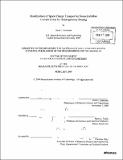Modification of space charge transport in nanocrystalline cerium oxide by heterogeneous doping
Author(s)
Litzelman, Scott J
DownloadFull printable version (49.54Mb)
Other Contributors
Massachusetts Institute of Technology. Dept. of Materials Science and Engineering.
Advisor
Harry L. Tuller.
Terms of use
Metadata
Show full item recordAbstract
In the search for new materials for energy conversion and storage technologies such as solid oxide fuel cells, nano-ionic materials have become increasingly relevant because unique physical and transport properties that occur on the nanoscale may potentially lead to improved device performance. Nanocrystalline cerium oxide, in particular, has been the subject of intense scrutiny, as researchers have attempted to link trends in electrical conductivity with the properties of space charge layers within the material. In this thesis, efforts designed to intentionally modify the space charge potential, and thus the space charge profiles and the macroscopic conductivity, are described.Nanocrystalline CeO2 thin films with a columnar microstructure were grown by pulsed laser deposition. A novel heterogeneous doping technique was developed in which thin NiO and Gd203 diffusion sources were deposited on the ceria surface and annealed in the temperature range of 7008000C in order to diffuse the cations into the ceria layer exclusively along grain boundaries. Time-offlight secondary ion mass spectrometry (ToF-SIMS) was utilized to measure the diffusion profiles. A single diffusion mechanism, identified as grain boundary diffusion, was observed. Using the constant source solution to the diffusion equation, grain boundary diffusion coefficients on the order of 10-15 to 10-13 cm2/s were obtained for Ni, as well as Mg diffusion emanating from the underlying substrate. Microfabricated Pt electrodes were deposited on the sample surface, and electrical measurements were made using impedance spectroscopy and two-point DC techniques. The asdeposited thin films displayed a total conductivity and activation energy consistent with reference values in the literature. After in-diffusion, the electrical conductivity decreased by one order of magnitude. Novel electron-blocking electrodes, consisting of dense yttria-stabilized zirconia and porous Pt layers were fabricated in order to deconvolute the ionic and electronic contributions to the total conductivity. In the as-deposited state, the ionic conductivity was determined to be pO2-independent, and the electronic conductivity displayed a slope of -0.30. The ionic transference number in the as-deposited state was 0.34. (cont.) After annealing either with or without a diffusion source at temperatures of 700-8000C, both the ionic and electronic partial conductivities decreased. The ionic transferene numbers with and without a diffusion source were 0.26 and 0.76, respectively. Based on the existing framework of charge transport in polycrystalline materials, carrier profiles associated with the Mott-Schottky and Gouy-Chapman models were integrated in order to predict conductivity values based on parameters such as grain size and the space charge potential. Mott-Schottky profiles with a space charge potential of 0.44V were used to describe the behavior of the ceria thin films in the as-deposited state. It is proposed that annealing at temperatures of 700TC and above resulted in segregation of acceptor impurity ions to the grain boundary, resulting in GouyChapman conditions. The best fit to the annealed data occurred for a space charge potential of 0.35 V: a decrease of approximately 90 mV from the as-deposited state. In addition, a high-conductivity interfacial layer between the CeO2 and substrate was detected and was determined to influence samples with no surface diffusion source to a greater degree than those with NiO or Gd203.
Description
Thesis (Ph. D.)--Massachusetts Institute of Technology, Dept. of Materials Science and Engineering, 2009. Includes bibliographical references (p. 161-170).
Date issued
2009Department
Massachusetts Institute of Technology. Department of Materials Science and EngineeringPublisher
Massachusetts Institute of Technology
Keywords
Materials Science and Engineering.